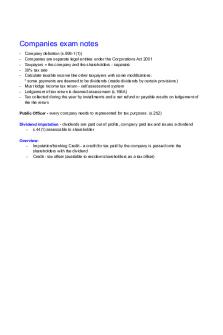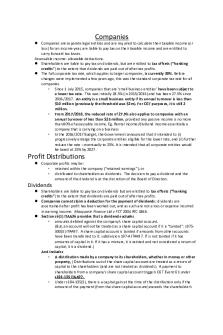Companies lecture notes PDF

| Title | Companies lecture notes |
|---|---|
| Author | Jasmine Sharpe |
| Course | Taxation Law 1 |
| Institution | University of South Australia |
| Pages | 3 |
| File Size | 89.7 KB |
| File Type | |
| Total Downloads | 75 |
| Total Views | 136 |
Summary
Download Companies lecture notes PDF
Description
Companies exam notes -
Company definition (s.995-1(1)) Companies are separate legal entities under the Corporations Act 2001 Taxpayers = the company and the shareholders - separate 30% tax rate Calculate taxable income like other taxpayers with some modifications: * some payments are deemed to be dividends (made dividends by certain provisions) - Must lodge Income tax return - self assessment system - Lodgement of tax return is deemed assessment (s.166A) - Tax collected during the year by installments and a net refund or payable results on ledgement of the the return Public Officer - every company needs to represented for tax purposes. (s.252)
Dividend imputation - dividends are paid out of profits, company paid tax and issues a dividend - s.44(1) assessable to shareholder Overview: - Imputation/franking Credit - a credit for tax paid by the company is passed onto the shareholders with the dividend - Credit - tax offset (available to resident shareholders as a tax offset)
Imputation system: - Not assessed twice - Company profits distributed to shareholders are effectively assessed at the ‘shareholders marginal tax rates’ - Undistributed company profits are taxed at the company level only (30%)
E.g . shareholder is on highest marginal rate, plus medicare levvy. Company Level
Shareholder Level
Taxable Income
$100
Dividend
$70
Tax (30%)
$30
Gross-up Amount
$30
After tax profits
$70
Amount in tax income
$100
Dividend Paid
$70
Tax (45% + 2%)
$47
Less Imputation Credit
$30
Tax Payable
$17
-
The total tax payable in respect of the $100 company profit is $47. Company pays $30 and Shareholder pays $17 The tax paid by shareholders on a dividend is determined by their marginal rate
Operation of the imputation system Dividend can be: - Fully franked - all taxed - Partially franked - part taxed - Unfranked - no tax paid **Process required to identify the tax paid by a company and is able to pass on as imputation credits with dividend. Can only issue franked dividends to shareholders when they have actually paid tax on the profits that its made.
Franking Account - Keep track of the tax paid on company profits by keeping a franking account. - Every company must keep a franking account (s.205-10) - From 1/07/02 the balance in the franking account represents the tax the company has paid on profits plus imputation credits on dividends received less imputation credits on dividends paid. - Franking Credit formula (s.202-60(2)) = dividend x 1 / 2.333 x %franked
Franking Deficits 1 July - Always will be credit balance or 0
Benchmark OVERFRANKING - NO CREDIT - do not credit this UNDER FRANKING - debit to account
Shareholder Effect - The company can own shares in another company - Gross-up already taken to the tax office - shareholder does not receive it (statutory income) - Other income and deductions are all tabulated and tax payable tabulated - subtract PAYG installments or withholding THEN: the individual would then be entitled to a tax credit (imputation credit) of $300 per s.20720(2)....
Similar Free PDFs

Companies lecture notes
- 3 Pages

Companies Act 1963 - Lecture notes 2
- 277 Pages

Companies EXAM Notes
- 9 Pages

Companies
- 1 Pages

Notes on Valuing Companies
- 137 Pages

CH3 Companies
- 3 Pages

Company law notes companies act 2013
- 48 Pages

S175 Companies Act 2006
- 1 Pages

Subsidiary and holding companies
- 5 Pages

FM Assignment (5 Companies)
- 24 Pages
Popular Institutions
- Tinajero National High School - Annex
- Politeknik Caltex Riau
- Yokohama City University
- SGT University
- University of Al-Qadisiyah
- Divine Word College of Vigan
- Techniek College Rotterdam
- Universidade de Santiago
- Universiti Teknologi MARA Cawangan Johor Kampus Pasir Gudang
- Poltekkes Kemenkes Yogyakarta
- Baguio City National High School
- Colegio san marcos
- preparatoria uno
- Centro de Bachillerato Tecnológico Industrial y de Servicios No. 107
- Dalian Maritime University
- Quang Trung Secondary School
- Colegio Tecnológico en Informática
- Corporación Regional de Educación Superior
- Grupo CEDVA
- Dar Al Uloom University
- Centro de Estudios Preuniversitarios de la Universidad Nacional de Ingeniería
- 上智大学
- Aakash International School, Nuna Majara
- San Felipe Neri Catholic School
- Kang Chiao International School - New Taipei City
- Misamis Occidental National High School
- Institución Educativa Escuela Normal Juan Ladrilleros
- Kolehiyo ng Pantukan
- Batanes State College
- Instituto Continental
- Sekolah Menengah Kejuruan Kesehatan Kaltara (Tarakan)
- Colegio de La Inmaculada Concepcion - Cebu





